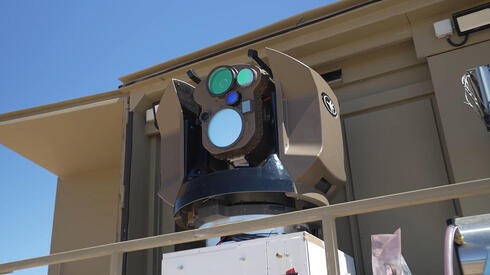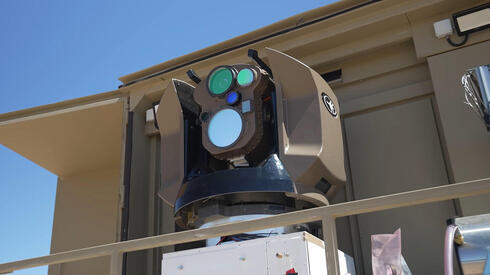
Laser-powered defense: How Iron Beam aims to transform Israel’s air defense capabilities
Laser-powered defense: How Iron Beam aims to transform Israel’s air defense capabilities
As interceptor missile costs soar, Israel’s laser solution promises economic and operational efficiency.
The Ministry of Defense's landmark agreement with Elbit Systems and Rafael, worth approximately NIS 2 billion, aims to accelerate the development and deployment of the Iron Beam defense system, a high-powered laser-based system, marking a significant step forward for Israeli defense companies into the era of laser weaponry.
Eyal Zamir, Director General of the Ministry of Defense, announced that the new system, designed to optimize and dramatically reduce the cost of intercepting rockets and UAVs, is expected to be operational within a year. Currently, interceptions of rockets and UAVs, mostly originating from Lebanon and Gaza, rely on Rafael’s Iron Dome system, which uses interceptor missiles costing approximately $50,000 each.
The Iron Beam system is intended to neutralize these threats with a laser beam, offering an almost zero-cost interception solution that could fundamentally alter Israel’s approach to defending against diverse threats. In April 2011, the first successful Iron Dome interception of a rocket from Gaza showcased the system's remarkable capabilities. However, criticisms arose around the cost-effectiveness of using expensive missiles against inexpensive, rudimentary rockets. Laser interception promises to reverse this economic imbalance.
According to the Ministry of Defense, since October last year, defense-related purchases from Israeli industries have amounted to approximately NIS 99.5 billion ($27 billion), with significant procurement directed toward central defense firms like Elbit Systems, the Israel Aerospace Industries (IAI), and Rafael. Additional investments also support other defense companies producing tank and APC components, drones, and UAV defense systems.
Israel’s shift toward laser weapons could also alleviate some of the challenges faced by the Israel Defense Forces (IDF), particularly as it navigates a multi-faceted, prolonged conflict. Laser technology could ease the Air Force’s logistical burden by reducing reliance on costly interceptor missiles, which require large-scale investments and dedicated production lines in both Israel and the U.S.
Part of the $8.7 billion U.S. aid package authorized by President Joe Biden to Israel has recently been allocated to bolster interceptor missile supplies for the Iron Dome and David’s Sling systems. This funding also supports the Iron Beam’s accelerated development, enabling the Ministry of Defense to finalize procurement with primary contractors Rafael and Elbit Systems, both collaborating on this ambitious initiative that is expected to transform the battlefield.
Hamas reportedly recognized this technological shift over a year ago. Documents seized by IDF forces in Gaza, as reported by The New York Times earlier this month, indicate that Hamas prioritized its large-scale October 7 assault due to concerns that Israel’s imminent deployment of the Iron Beam would hinder their capacity to launch rocket and mortar barrages against Israel.
Despite expectations, those hoping Iron Beam would fully replace Iron Dome batteries may be disappointed. In its initial phase, Iron Beam is primarily intended for short-range threats, such as rockets and mortar bombs. The system faces operational limitations, particularly in adverse weather conditions like clouds or haze, which can disrupt the laser’s focus. Defense companies are actively working to address these issues to enhance Iron Beam’s efficacy in various environments.
Iron Beam will not function as a standalone system but will integrate with the Iron Dome’s detection infrastructure, allowing rapid decision-making on whether to intercept a target with a laser beam or a missile. This integrated approach is one reason the defense establishment selected Rafael as the project’s main contractor. Laser interception components are supplied by Elbit’s Intelligence and Electronic Warfare Division, which has extensive experience in developing laser-based defense technologies.
Israel’s defense sector is not alone in pursuing laser capabilities, though it remains a global leader. For example, U.S.-based Lockheed Martin partnered with Rafael two years ago to explore laser weapons, aiming to develop exportable versions of the system.
Recently, Rafael introduced a new concept based on this technology for mobile protection, designed to shield maneuvering forces in combat zones from UAVs and mortar bombs. Iron Beam shows promise in UAV interception, though further developments are needed in detection and identification to improve reliability.
Elbit Systems, which received roughly $200 million from the laser program, is positioned for future growth, planning to support and maintain these systems for years. It intends to expand its laser-based defense solutions, potentially incorporating UAVs and other aircraft capable of targeting and intercepting distant threats. Following news of the agreement, Elbit shares surged nearly 6%.
Several challenges remain, including refining the focus of the laser between multiple fast-moving objects and miniaturizing the system for aircraft deployment. However, in aerial applications, operating above clouds and haze could extend the system’s range. According to defense sources, the hardest technical hurdles have been overcome, and some capabilities Elbit is pursuing may soon be operational. These advancements have strengthened Elbit’s position in air defense, a field currently led by IAI and Rafael, both of whom are advancing systems to counter emerging hypersonic missile threats.















